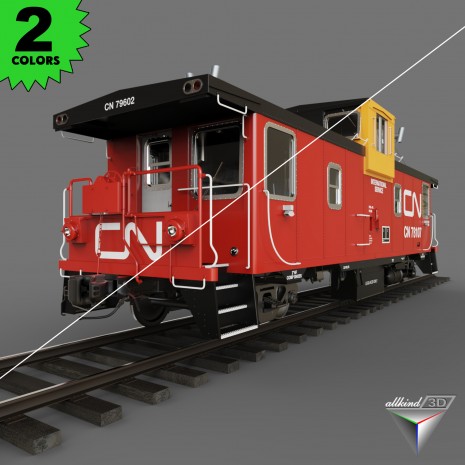railcar caboose CN PSC
- Type of modelling High Poly
- Geometry Polygonal
- Poligons 583881
- Vertices 584924
- Smooth iteration 1
- Textures Yes
- Rigged No
- Animated No
- Formats FBX , OBJ , MAX
- Archive Size 67,9 mb
- Published 14-04-2024
Description
3D model of а caboose Canadian National (PSC)
About the prototype:
In the early 1960s, Canadian National Railways (CN) was faced with the need to to replace its large fleet of old wooden cupola escort railcars ("cabooses"). There was a need for more technologically advanced, convenient and comfortable for the train escort crews work cabooses that would meet the requirements of a modern railway. It was decided to use the 1937 AAR freight boxcars of the 472000 series as a basis. The new design was the result of four years of study, experimentation and consultation between CN and the brotherhood of Railroad Trainmen. The railcars were to be equipped with roller bearings , Barber-Bettendorf tracks specially designed for cabooses and shock absorbing underframes.
As early as 1964, CN ordered 150 cabooses from Hawker-Siddeley Transport (HST) on a project specially designed for CN. By 1967, they were already built and numbered from CN 79200 to CN 79349. But this amount of cabooses was not enough.
Since 1970, the Pointe St.Charles workshop (PSC, since 1993 AMF Technotransport) in Montreal, owned by Canadian National Railways, has been commissioned to build 548 cabooses. By 1977 the order was complited. The cabooses were numbered from CN 79350 to CN 79897.
In 1982, the first batch of 25 cabooses (approximately 40 cabooses between 1982 and 1989) were taken out of service to be retrofitted to FRA (US Federal Railroad Administration) standards and sent on international rides (to the U.S.). The FRA standard required the glazing of the caboose to be bulletproof and vandal-resistant, (for example, to withstand a 22 calibre bullet fired at 960 feet per second and the impact of a 24 pound cinder block). The cabooses were renumbered as 79900-79924 and sent for international service. There were retrofitted additional CN 78130-CN 78134 in 1987 and CN78135 to CN 78140 in 1989. Apart from the glazing, the international cabooses were distinguished from the regular cabooses by a yellow cupola, markings 'International Service' underneath it and an inscription in the cabin stating that the railcar met the requirements for crossing the border.
Another three cabooses were sold to Alaska RailRoad Corporation in 2000. These are probably cars that were earlier in International Service, as they had already been modified to FRA standards.
Six identical railcars were built at Pointe St.Charles workshop, numbered 9601-9606 for the Algoma Central Railway in 1976.
The first few PSC cabooses had tubes right next to the cupola not to obstruct the view, and the tandem of air duct and chimney went in a square box on the roof of the railcar to the chimney near the cupola.
But this idea was unsuccessful, and in all subsequent cabooses the chimneys were installed directly above the heaters, and the air inlet was through the air intake in the side of the car. Even almost all cars of the first batch were subjected to remodelling.
The railcar is powered by lead-acid batteries, which are charged by a generator installed under the railcar bottom and connected to the bogie gearbox via a cardan shaft. Late model cabooses did not have batteries, but had a propane tank and a propane-powered generator.
The HST cabooses differed from the PSC cabooses in details, but the basic idea was identical. A modern caboose should have a wide-cupola in the centre of the railcar, it also shold be with large windows and a good view along the train, autonomous in terms of electricity, water, heating, sanitary and hygienic facilities and the possibility of comfortable work, meals and rest for the escort train crew. The new cabooses received large windows.
All end windows have windscreen wipers.
But on the PSC cabooses, the windows were larger and all end windows were also tilted to avoid glare.
The interior is made with an emphasis on comfort. The caboose is equpied with the captain's swivel chairs, footrests, dining area with table, kitchen area with kitchenette, cold and hot water, chemical toilet, desks for paperwork, sofa, first aid kit, two oil-fired space heaters at different ends of the car, ceiling mounted grab irons, lockers for tools and equipment.
The lighting equipment of the new cabooses was very different from its predecessors. In the ends of the roof there were red (for the ending position in the train) and green operating marker lights (in cases when the caboose acted as the head of the train). The track headlights switched on when reversing of the train or in poor visibility conditions to indicate the end of the train were installed on the ends of the railcar. The caboose was also equipped with step lights and handrails lights.
Canadians themselves called the caboose a van. Other nicknames are also known - crummy, parlor, shanty, bed house, doghouse, etc.
Nevertheless, the caboose also served as a first aid and warming station, as well as a mobile cabin that allowed hunters or fishermen transportation back to town.
The caboose is made of metal, glass, wood.
The following colouring options are available:
- CN 79602 (the standard colouring Canadian National Railway)
- CN 78107 IS (the colouring of the caboose for foreign travelling)
Features:
Year built - 1970-1977
Tracks - Barber-Bettendorf T-208
Gauge - 4'8 1/2" (1435мм)
Type AAR - M930
Class AAR - NE
*******************************************
Dimensions, inches, mm:
Length - 46' 1 1/2" (14060мм)
Height - 15' 3 1/4" (4780мм)
Width - 11' (3360мм)
Rails - 100 lb/yard P-class length - 31'9'' (967.8 cм), approoved American Railway Engineering Association (or AREA) since 1919)































